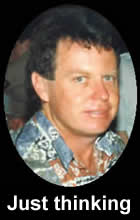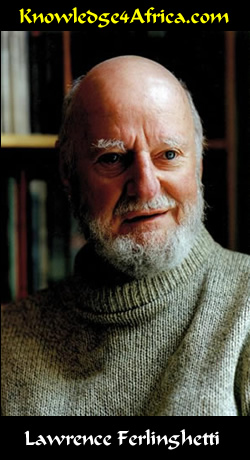|
READ THIS
This clever little poem looks at the poet and his art, comparing him to an acrobat in the circus who
performs all his amazing tricks to amuse and dazzle his audience.
 ABOUT THE POET
ABOUT THE POET
Lawrence Ferlinghetti was born in New York in March 1919 but was soon sent to a relative in France
because of his mother's being committed to a mental asylum. He would return to America at the age of
five.
Although he began to write poetry at an early age, his teenage years saw him mixed up with street-gangs
and soon under arrest for theft. He nevertheless completed high school and proceeded to the University
of North Carolina where he obtained a degree.
During the war years he joined the United States navy, serving as an officer. On his discharge in 1945,
he studied for a Master's Degree at Columbia University and then proceeded to the Sorbonne in Paris
where he graduated with a Doctorate in Literature.
By 1952 he was back in America. He and a friend opened a bookstore in San Francisco, which they
named City Lights, the title of a famous Charlie Chaplin movie. The bookstore became the centre
for a movement of writers and artists known as the "Beat" group.
Ferlinghetti also established a publishing house which specialised in poetry. He quickly became known
as one of the most influential of American poets and, in 1998, he was named as Poet Laureate for San
Francisco.
Have you looked at the questions
in the right column?
|
TEST YOURSELF!
Read the left column and then answer
the following questions:
If one were to divide this poem into logical parts, where would one do it? (4)

[Need help?]
Although the poet does not use punctuation, it is possible to identify three logical breaks -- each identified
with the use of the upper-case:
- "Constantly risking absurdity . . . "
- "For he's the super realist . . . "
- "And he a little charleychaplin man . . . "
|
This poem is an outstanding example of an extended metaphor (a.k.a. sustained
metaphor).
- What is an extended metaphor? (4)

[Need help?]
A metaphor is an imaginary application of the characteristics of a real object to another object
where it cannot be literally applicable. e.g. The smiling sun; Oh happy day!
The extended metaphor happens when the poet or author sustains the same metaphor over a
period of perhaps a verse or a paragraph, or perhaps even the whole poem.
|
- In what way is this poem an example of an extended metaphor? (4)

[Need help?]
In this poem, Ferlinghetti compares the poet to an acrobat in the circus who has to perform dangerous
feats on the high-wire. The metaphor of the acrobat is then sustained throughout the poem.
|
"Constantly risking absurdity
and death
whenever he performs
above the heads
of his audience
the poet like an acrobat
climbs on rime
to a high wire of his own making
and balancing on eyebeams
above a sea of faces"
- In what way is the poet "constantly risking absurdity"? (4)

[Need help?]
The acrobat risks his career and his life on the high wire. Should he make an idiot of himself, his career
would be over. Should he fall, his life might be over.
In many ways it is similar for the poet who also has to rise to great heights of poetic mastery to be
respected as a poet. In doing so, he too takes great risks.
Should he overstep himself, should his risk fail, it might forever damage his career as a poet.
Overstepping himself could banish him to the "lunatic fringe" of those poets who are no longer
taken serious. Not being taken seriously is death to a serious poet.
|
- Why should he be risking both "absurdity and death"? (4)

[Need help?]
The philosopher Albert Camus said that absurdity is worse than death for the artist.
Have you ever thought why it is that so few psychologists spend any time researching the paranormal?
It's simply because the majority of their scientific peers do not believe in the paranormal.
Should the psychologist produce evidence of psychic powers, therefore, his research would be open to
rebuttal and ridicule. At best, he will receive no further funding. He might, however, see his tenure ended
for bringing his institution into disrepute.
Should a poet go too far in his "absurdity", he too can quite suddenly lose his credibility as a poet.
He will then be tossed onto the rubbish heap of has-been poets, doomed to be read by no-one except
perhaps the lunatic fringe.
|
- In what way could the poet be said to be performing "above the heads of his
audience"? (4)

[Need help?]
A poet can never perform at the level of his audience, just as a tightrope-walker can never walk a wire that
is suspended only centimetres above the ground. The poet has to go up high, challenge his readers, force
his readers to think. A poem which does not challenge will never become part of a serious anthology to
be read again and again.
|
- Is there any reason why the poet uses the spelling "rime" instead of
"rhyme"? (4)

[Need help?]
"Rime" is the archaic form of "rhyme".
It is possible that the poet has used the shortened archaic form both because it is short like "rung"
(the poet is comparing his profession with the acrobat who climbs the rungs to the high-wire) and
because it pushes the boundaries of absurdity, forcing the readers to think.
Or is it just American spelling? After all, America often uses archaic forms of spelling.
|
- Comment on the poet's image "balancing on eyebeams". (4)

[Need help?]
The use of the word "eyebeams" conjures up magical properties. One can imagine invisible,
magical beams emanating from the eyes of the readers, beams which become the highwire along which
the poet dances and conjures his magical tricks with words.
|
|



